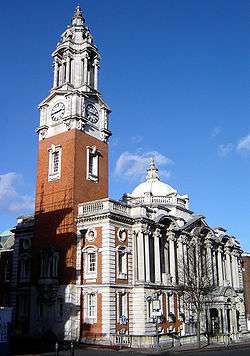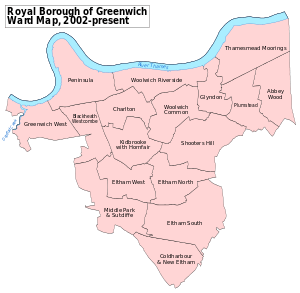Greenwich London Borough Council
Greenwich London Borough Council is the local authority for the Royal Borough of Greenwich in Greater London, England. It is a London borough council, one of 32 in the United Kingdom capital of London. Greenwich is divided into 17 wards, each electing three councillors.[1] The council was created by the London Government Act 1963 and replaced two local authorities: Greenwich Metropolitan Borough Council and Woolwich Metropolitan Borough Council. The council meets in Woolwich Town Hall.
Greenwich London Borough Council | |
|---|---|
 | |
| Type | |
| Type | London borough council of the Royal Borough of Greenwich |
| Leadership | |
Mayor of the Royal borough of Greenwich | Cllr Mick Hayes since May 2019 |
Leader of the Council | Cllr Danny Thorpe, Labour since May 2018 |
Chief executive | Debbie Warren since 12 December 2018 |
| Structure | |
| Seats | 51 councillors in 17 wards (1 Vacancy) |
 | |
Political groups | Administration (41)
Opposition (9)
|
| Elections | |
| First past the post | |
Last election | 2018 |
Next election | 2022 |
| Meeting place | |
 | |
| Woolwich Town Hall | |
| Website | |
| www | |
History

There have previously been a number of local authorities responsible for the Greenwich area. The current local authority was first elected in 1964, a year before formally coming into its powers and prior to the creation of the London Borough of Greenwich on 1 April 1965. Greenwich London Borough Council replaced Greenwich Metropolitan Borough Council and Woolwich Metropolitan Borough Council.[2]
It was envisaged through the London Government Act 1963 that Greenwich as a London local authority would share power with the Greater London Council. The split of powers and functions meant that the Greater London Council was responsible for "wide area" services such as fire, ambulance, flood prevention, and refuse disposal; with the local authorities responsible for "personal" services such as social care, libraries, cemeteries and refuse collection. This arrangement lasted until 1986 when Greenwich London Borough Council gained responsibility for some services that had been provided by the Greater London Council, such as waste disposal. Greenwich became an education authority in 1990. Since 2000 the Greater London Authority has taken some responsibility for highways and planning control from the council, but within the English local government system the council remains a "most purpose" authority in terms of the available range of powers and functions.[3]
In May 2014 the Labour-run council refused to support the building of a memorial to Lee Rigby, whose murder by Islamists occurred in the borough, in spite of being "overwhelmed by interest in a local memorial". The authority previous faced criticism at the time of the killing, with the cabinet attending an away day immediately after the murder, therefore missing a visit by the Prime Minister.[4] Following a campaign which saw 25,000 people sign a petition in support of the memorial the council dropped its opposition to the tribute.[5]
Powers and functions
The local authority derives its powers and functions from the London Government Act 1963 and subsequent legislation. Greenwich has the powers and functions of a London borough council. It is a billing authority collecting Council Tax and business rates, it processes local planning applications, it is responsible for housing, waste collection and environmental health. It is a local education authority, responsible for social services, libraries and waste disposal. The council shares responsibility with the Greater London Authority for strategic policies including housing, planning and the environment.[6]
Finances
Greenwich London Borough Council is the billing authority for Council Tax, and collects precepts on behalf of the Mayor's Office for Policing and Crime, the London Fire and Emergency Planning Authority the Greater London Authority and Transport for London.[7]
Summary results of elections
| Overall control | Labour | Conservative | Lib Dem | SDP | |
| 2018 | Labour | 42 | 9 | - | - |
| 2014 | Labour | 43 | 8 | - | - |
| 2010 | Labour | 40 | 11 | - | - |
| 2006 | Labour | 36 | 13 | 2 | - |
| 2002 | Labour | 38 | 9 | 4 | - |
| 1998 | Labour | 52 | 8 | 2 | - |
| 1994 | Labour | 47 | 8 | 3 | 4 |
| 1990 | Labour | 44 | 12 | 2 | 4 |
| 1986 | Labour | 44 | 12 | 2 | 4 |
| 1982 | Labour | 43 | 16 | 2 | 1 |
| 1978 | Labour | 45 | 17 | - | - |
| 1974 | Labour | 52 | 8 | - | - |
| 1971 | Labour | 55 | 5 | - | - |
| 1968 | Conservative | 22 | 38 | - | - |
| 1964 | Labour | 49 | 11 | - | - |
References
- "Archived copy". Archived from the original on 21 November 2011. Retrieved 24 October 2010.CS1 maint: archived copy as title (link)
- Youngs, Frederic (1979). Guide to the Local Administrative Units of England. I: Southern England. London: Royal Historical Society. ISBN 0-901050-67-9.
- Leach, Steve (1998). Local Government Reorganisation: The Review and its Aftermath. Routledge. p. 107. ISBN 978-0714648590.
- telegraph.co.uk: "Lee Rigby memorial: 'All I want is to know my son will not be forgotten’" (Gilligan) 17 May 2014
- telegraph.co.uk: "Lee Rigby memorial: victory at last for campaigners" 11 Jun 2014
- "Local Plan Responses – within and outside London". Mayor of London. Retrieved 9 April 2020.
- "Council Tax and Business Rates Billing Authorities". Council Tax Rates. Retrieved 8 April 2020.
| Awards and achievements | ||
|---|---|---|
| Preceded by Southend-on-Sea |
LGC Council of the Year 2013 |
Succeeded by Durham |
